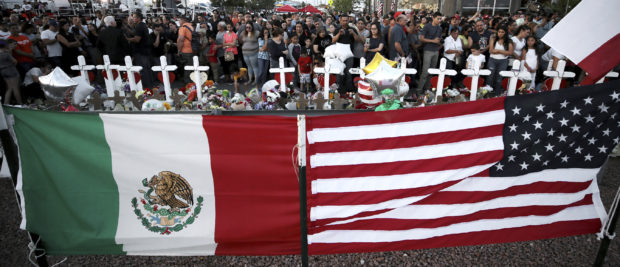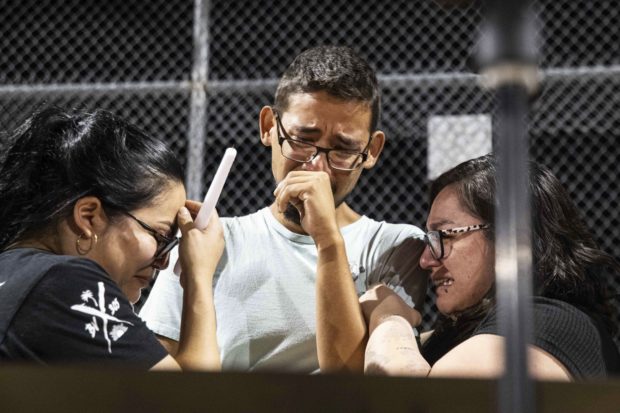El Paso, with deep Mexican American past, rallies amid pain

People show up in masses Monday, Aug. 5, 2019, to pay their respects to those who lost their lives in Saturday’s attack in El Paso, Texas. (Mark Lambie/The El Paso Times via AP)
The massacre that killed 22 people at a Walmart in El Paso struck a city that has long been the cradle of Mexican American culture and immigration and suffered through bloody episodes of racial violence in the past.
The white gunman apparently wrote an anti-Hispanic rant before opening fire with an AK-47-style rifle on Walmart shoppers – many of them Latino – rattling a city that has helped shape Mexican American life across the U.S. for generations.
Many Mexican Americans in Los Angeles, New Mexico, Texas, Colorado, and beyond can trace their families’ roots to El Paso, sometimes called the “Ellis Island” of the border. The city served as a port of entry where immigrants from the interior of Mexico had to come to gain entry into the United States before World War II.
Mexican Revolutionary leader Pancho Villa visited the city. Country artist Marty Robbins famously sang in 1959 about falling “in love with a Mexican girl” here. It is the birthplace of civil rights lawyer Oscar Zeta Acosta, journalist Ruben Salazar, and poet Pat Mora. The city is also a geographic center of sorts for Mexican Americans, sitting about the same distance to Los Angeles as it is to Houston.
“El Paso has a deeper history than what you see on the news,” said Sergio Troncoso, an El Paso-born novelist who now lives in New York City. “That manifesto shows that white nationalists continue to reduce El Paso to immigration and a place of foreigners. It’s so much more than that.”
Article continues after this advertisementIn the last year, El Paso has garnered attention because of the rapid rise of migrants from Central America coming to seek asylum. The city also has been a testing ground for immigration enforcement, with the government spending millions of dollars on agents, barriers, and border security technology and equipment.
Article continues after this advertisementPresident Donald Trump, who is visiting the city on Wednesday, has cited El Paso’s crime rate as proof for why his border wall is needed, despite FBI statistics that show the city routinely has a violent crime rate below the national average. Crime statistics also show the city to be safer than other municipalities the same size in population.
Why the alleged shooter chose El Paso as his target remains a mystery. But the online rant investigators have attributed to him speaks of a “Hispanic invasion of Texas” and theories of non-white immigrants replacing whites.
Anthony Medrano, an El Paso resident, said he wished the shooter would have paused and thought just a moment before hurting people shopping in the predominantly Mexican American city of 700,000.
“We would have shown him what a great place this is, where you can walk out at night and not get mugged,” Medrano said.

Three Walmart workers, Melisa Gonzalez, Jesus Romero and Raven Ramos, who helped people to escape during the mass shooting on Saturday, Aug. 3, 2019, get emotional during during a vigil at Ponder Park in honor of the shooting victims in El Paso, Texas on Sunday, Aug. 4, 2019. (Lola Gomez/Austin American-Statesman via AP)
The El Paso area was settled in the late 1500s after the arrival of Spanish conquistador Juan de Oñate during an expedition through current-day New Mexico to establish a colony as part of New Spain.
It became an important northern hub of the Spanish empire and later a key spot in the American Southwest as the railroads expanded into what was disputed territory during the U.S. Civil War.
A century ago, El Paso was also the site of notorious racial violence – a history that resonated with residents after last weekend’s massacre.
In 1916, white mobs and drunken U.S. soldiers attacked innocent Mexican Americans in the city after Villa’s soldiers in Mexico killed 19 white engineers and staff from an American mining company. El Paso white police also are believed to have sought revenge and set fire to Mexican American inmates in the El Paso jail, killing 27.
U.S. officials at a border bridge in El Paso in the early 1900s routinely deloused and sprayed the clothes of Mexicans crossing into the U.S. with Zyklon B – a poisonous pesticide invented in Germany in the 1920s.
“There were many cases of racial violence in El Paso targeting Mexican Americans,” said Monica Muñoz Martinez, the author of “The Injustice Never Leaves You: Anti-Mexican Violence in Texas” and an American studies professor at Brown University. “The memories of those acts live on.”
After World War II, however, returning Mexican American veterans helped elect in 1957 Raymond L. Telles, Jr. – the first Mexican American mayor of a major U.S. city. He sought to include Mexican Americans in key positions like police chief and outlined a blueprint for civil rights leaders to follow in other cities with sizable Latino populations.
The city is credited with shaping modern Mexican American political activism and with giving birth to the “pachuco” – a word that describes a Mexican American youth subculture associated with zoot suits and gang life. (The city’s nickname is “El Chuco.”)
Daniel Chacon, a novelist who was raised in Fresno, California, but whose father was from El Paso, said the climate since the Telles years gave birth to a booming Mexican American literacy and artist scene.
“It became a bedrock of (American) Southwest culture. It’s an American city,” said Chacon, who now chairs the Creative Writing Department at the University of Texas at El Paso. “The only invasion that has happened here in the last 100 years was the one at Walmart this Saturday.” /kga